|
This rescue is reported to be one
of the most dangerous in the Vietnam War. The photo of LCDR Tucker being lifted into the rescue helicopter is one of
the iconic photos from this war.
The numerous rescue accounts
don't mention the presence of A-1 Skyraiders with the exception of the account in the book "Leave No Man Behind" as shown
below.
The only
record of Jack and his wingman's names being mentioned in this rescue that I am aware of is in the below history
of VA-152 written by one of the unit's pilots who was on the 1966 cruise aboard the USS Oriskany. You can read that
portion of the history in the below paragraph.

(From the book "VA-152, A SPAD
SQUADRON IN VIETNAM", a history of VA-152 during the time the squadron served in
Vietnam aboard the USS Oriskany in 1965, 1966 and 1967. This history was written by LT J.M. (Bud) Watson
in December of 1967. )
On 31 August LT Feldhaus and LTJG Guenzel escorted a helicopter
into the middle of Haiphong harbor to pick up LCDR Tucker of VFP-63 while ORISKANY Jets covered them.

I decided to do a little investigation to see what I could learn about this rescue effort. You
can read the results below:

I reviewed the National Archives electronic database "Combat Air Activities Files (CACTA), created, 10/1965 - 12/1970, documenting the period 10/1965 -
12/1970 - Record
Group 218" for all RF-8 flights from the USS Oriskany on 31 Aug 1966 and located
two PHOTO RECCE single aircraft missions, 1160 and 1175.
The 1175 mission contained coordinates for the beginning of the mission at 204300N10565000E
and the end of the mission at 210300N1073800E.
Based on these coordinates, I plotted the approximate route of what appears to be LCDR Tom Tucker's
RF-8 aircraft the day he was shot down over Haiphong harbor and rescued. I show the location of the USS Oriskany during the day of 31 Aug 1966 as obtained from the Deck
Log, which is available on the internet. The Deck Log also shows the arrival of Indian Gal #53 helicopter at 5:20 PM and the aircraft leaving
at 5:56 PM. At 7:05 PM Indian Gal #68 arrived and departed at 7:07 PM. Based on what the co-pilot of the Indian
Gal rescue helicopter told me below, I believe either Indian Gal 53 or Indian Gal 68 was the rescue helicopter for LCDR Tom
Tucker.
The location of the A-1 Skyraider's missions was
obtained from the National Archives records noted above.
Not sure if my brother Lt. Jack Feldhaus
and wingman Ltjg Fred Guenzel responded to the downed airman from an armed reconnaissance mission or were dispatched from
the Oriskany as two A-1 Skyraiders flew RES CMBT AIR PATROL (RESCAP) missions on 31 Aug 1966 according to the National
Archive records noted above.
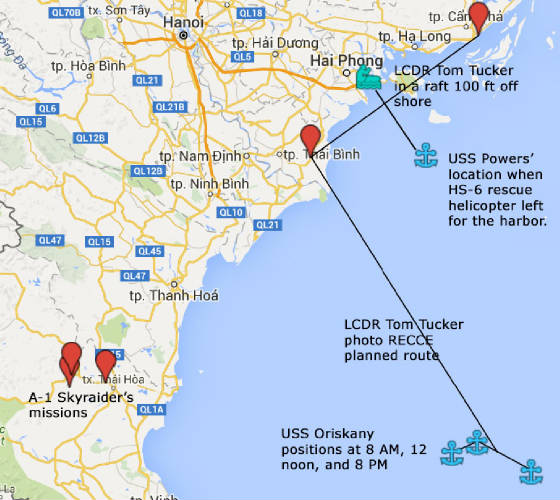

The below blow-up of the rescue location shows where LCDR Tom Tucker
was located inside the harbor, the path of the rescue helicopter, and a section of the original planned photo RECCE
route.
The harbor channel is almost exactly 1 mile wide at the location where I believe LCDR Tom Tucker
was on his raft in the water.


The below map is an interactive Google map that allows the
viewer to increase or decrease the size of the map and pan around the map to view various details. You can zoom in close
enough to see ships in the harbor, both at piers and under way.

9 February 2016 I talked to CDR William "BILL" Ellis Runyon, the co-pilot
of the "Big Mother" helicopter who carried out this spectacular rescue of LCDR Thomas A. Tucker from Hiaphong Bay in North
Vietnam on 30 August 1966.
He retired from the Navy as a Commander, serving the last several years on the east coast, including
stints at he Pentagon in senior positions. Bill was
co-pilot on an HS-6 "Indian Gal" helicopter with the squadron CO, CDR Robert Vermilya as pilot. That day they were
assigned to the North CSAR Destroyer USS Towers. (Towers was equipped to refuel the SAR helicopters in flight). Bill was the one flying the helicopter into Haiphon Harbor with the shore on his side of the
helicopter. As they entered the harbor automatic weapon fire was coming from the shore and he thought at any
minute he would be hit. He had initially flown at 3,000
feet altitude, believing SAM missiles could not attack a plane at that low height, however when a SAM exploded overhead seconds
after they received a "missile away" warning, he descended to the deck in an attempt to avoid being hit. Once the downed pilot was located, CDR Vermiyla took control of the helicopter and maneuvered to
recover LCDR Tucker. I asked Bill if he remembered
being escorted into the harbor by any friendly planes. He said that once over the beach the trip to the downed airman
was short and they didn't need an escort. I asked Bill what role the Spads had in the rescue. He told
me the two Spads where in the harbor when the helicopter arrived. He said the Spads were busy sinking boats
that were trying to get to LCDR Tucker and used their 20 MM cannons in response to automatic weapon fire coming from the junks
and the beach. Once LCDR Tucker
was in the helicopter they dropped him off at the duty North CSAR Destroyer USS Towers (DDG-9).
They were still on CSAR duty and had to complete their watch before they could be relieved. When their CSAR duty was over, they retrieved LCDR Tucker from the USS Towers and
took him to his carrier, the USS Oriskany, where the helicopter crew were treated as heroes and showered with gifts.
CDR Vermiyla was initially recommended for the Medal of Honor but eventually
was issued a Silver Star for his role in the rescue. Bill received a Distinguished Flying Cross for his part.

The below excerpts
are from a communication by Commander Attack Carrier Air Wing SIXTEEN to
Chief of Naval Operation giving the Command History Air Wing 16 during
1966. It was submitted 23 January 1968.
Notice
that their is no mention of any A-1 Skyraiders (non-jet aircraft) on the scene, although there is mention of "RESCAP aircraft"
being 25 minutes away at one point in the rescue.
This contradicts what Bud Watson wrote in the VA-152 squadron history and also what the book "Leave No Man Behind"
reported as shown below.
It
also contradicts what CDR William "BILL" Ellis Runyon, the co-pilot
of the "Big Mother" helicopter related to be about the rescue.
I believe the timing between the rescue in August 1966 and this report
issued in January 1968 give cause for doubt about the accuracy of the report.
Further, the fact that he died in the Oriskany fire in October 1966 may have been motivation for embellishment
of his role in this rescue.
31
AUGUST Another Successful RESCAP
Lieutenant Commander SMITH
(MY
NOTE: LCDR James Andrew Smith, USS Oriskany squadron VAH-4, flying
an A3-E Skywarrior was the
leader of a two plane flight which) was engaged in armed road reconnaissance
south of Than Hon, North Vietnam on 31 August 1966.
(MY NOTE: LCDR Smith would lose his life in the fire
aboard the USS Oriskany on 26 October 1966)
Hearing an emergency radio transmission that a
pilot was down near Hiaphong, he immediately gathered his flight and proceeded
to Hiaphong at maximum speed. He was in radio contact with the downed pilot's
wing-man as well as the SAR destroyer, the airborne tanker, the BARCAP, the RESCAP,
and the rescue helicopter.
The RESCAP aircraft were about twenty-five minutes away from the scene. (My
note: The RESCAP aircraft would have been the two A-1 Skyraiders piloted by my brother Lt
John "Jack" Feldhaus and his wingman Ltjg Fred Guenzel).
Lieutenant
Commander SMITH proceeded to the
downed pilot, located him in the water, and informed the SAR destroyer that a
rescue was possible.
He assumed the role
of on-scene commander and took charge of the SAR effort as director and
coordinator. He positioned the tanker
over the destroyer for future in-flight refueling and instructed the BARCAP to remain
clear at a safe distance from the coast to be called in if needed.
A second
section of jet attack aircraft arrived on the scene and
provided mutual support, as directed, to SMITH's section.
He remained over the pilot in the water
keeping him in sight and provided immediate air-to-ground ordnance delivery
capability against any threat to the downed pilot. He was within range of many
coastal anti-aircraft positions and was only five miles from Cat Bi Airfield. In
addition, he was within range of three
known SAM sites and while flying in the area received four SAM alerts and one
"Missiles Away" warning.
When the rescue helicopter was about ten miles south,
he proceeded to the
helo, located it and escorted it to the pilot, giving steers as necessary to
ensure an expeditious recovery and thus provide minimum exposure to the helo
and to the downed pilot. Once the rescue
had been completed, SMITH and his flight of four aircraft escorted the helo out
of this very hazardous area.
The
entire SAR operation was conducted smoothly and rapidly. Significant also is
the fact that the downed
pilot floated a mere 800 yards from the coast and practically in the harbor of
Hiaphong.

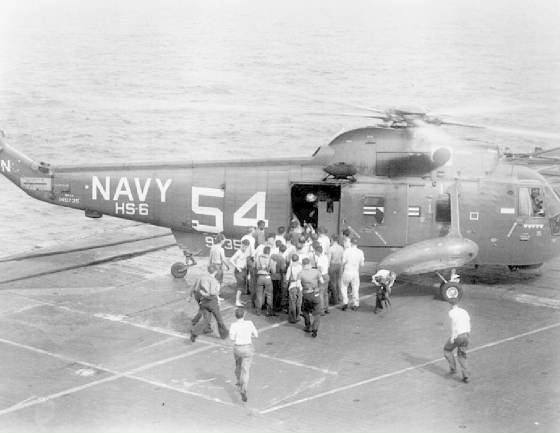
Crewmen on board the U.S. Navy aircraft carrier USS Oriskany
(CVA-34) rush to an Sikorsky SH-3A Sea King (BuNo 149735) of Helicopter Anti-Submarine Squadron HS-6 Indians
to retrieve oxygen breathing apparatus to fight a fire on board. HS-6 was assigned to Carrier Anti-Submarine Air Group 53
(CVSG-53) aboard the USS Kearsarge (CVS-33) for a deployment to Vietnam from 9 June to 20 December 1966.
This photo of the SH-3A Sea King from
HS-6 bears the number 54 and it was 53 that landed on the USS Oriskany on 31 August 1966 with the rescued airman LCDR
Tucker.
This photo gives an excellent
perspective of the size of the aircraft relative to the Oriskany crewmen in front of it.

The HS-6 Raunchy Redskins web site details this rescue from the perspective of the helicopter
crew and provides the following information:

|
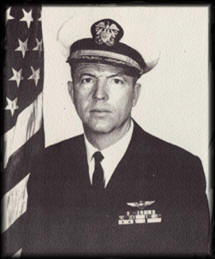
CDR Robert S. VERMILYA
|
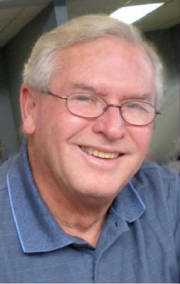
William "Bill" E. Runyon 2009
|
SYNOPSIS OF THE EVENTS PRECIPITATING THE FOLLOWING AWARDS
CDR R.S. VERMILYA SILVER STAR MEDAL
ENS W.E. RUNYON DISTINGUISHED FLYING CROSS
AXC T. GRISHAM AIR MEDAL
ADJ2 J. D. DUNFORD AIR MEDAL
The helicopter crew vectored to a position deep within Haiphong Harbor to
rescue a downed Navy fighter pilot. The survivor had been located in a raft by
covering aircraft one hundred yards off-shore in the narrow channel between the
Isle De Dinh Vu and the mainland.
As
the helicopter approached the entrance to
the harbor, it was taken under heavy fire by enemy AAA and automatic weapons
batteries. Employing evasive maneuvers to reduce the effectiveness of
concentrated fire from the antiaircraft batteries and to avoid numerous junks,
the crew tenaciously proceeded toward the heart of the enemy port.
As the
helicopter approached the survivor, he was observed to be caught in heavy
crossfire from automatic weapons located on both shores of the channel.
Supporting attack aircraft eluded enemy surface to air missiles to make numerous
fire suppression runs on the enemy guns so the helicopter could approach the
downed pilot. In spite of these efforts, the enemy persisted in his attempts to
shoot down the rescue aircraft.
The
survivor furiously paddled his raft in a
valiant but futile effort to open the distance between himself and the enemy. It
seemed that the downed pilot's capture was imminent.
The crew evaluated the
situation and decided that only by taking a calculated risk and proceeding
immediately with the rescue could the downed pilot possibly be saved from
capture.
Skillfully
executing a rescue approach and hover, the crew quickly
snatched the downed pilot out of his precarious position and took him aboard the
helicopter.
After
making a rapid departure from the rescue scene, the helicopter
continued to be a prime target and presented the enemy with his last opportunity
to thwart the success of the rescue mission.
Finally, the
helicopter reached the safety of the open sea after being subjected for more than 20
minutes to all the fire which the enemy could muster.

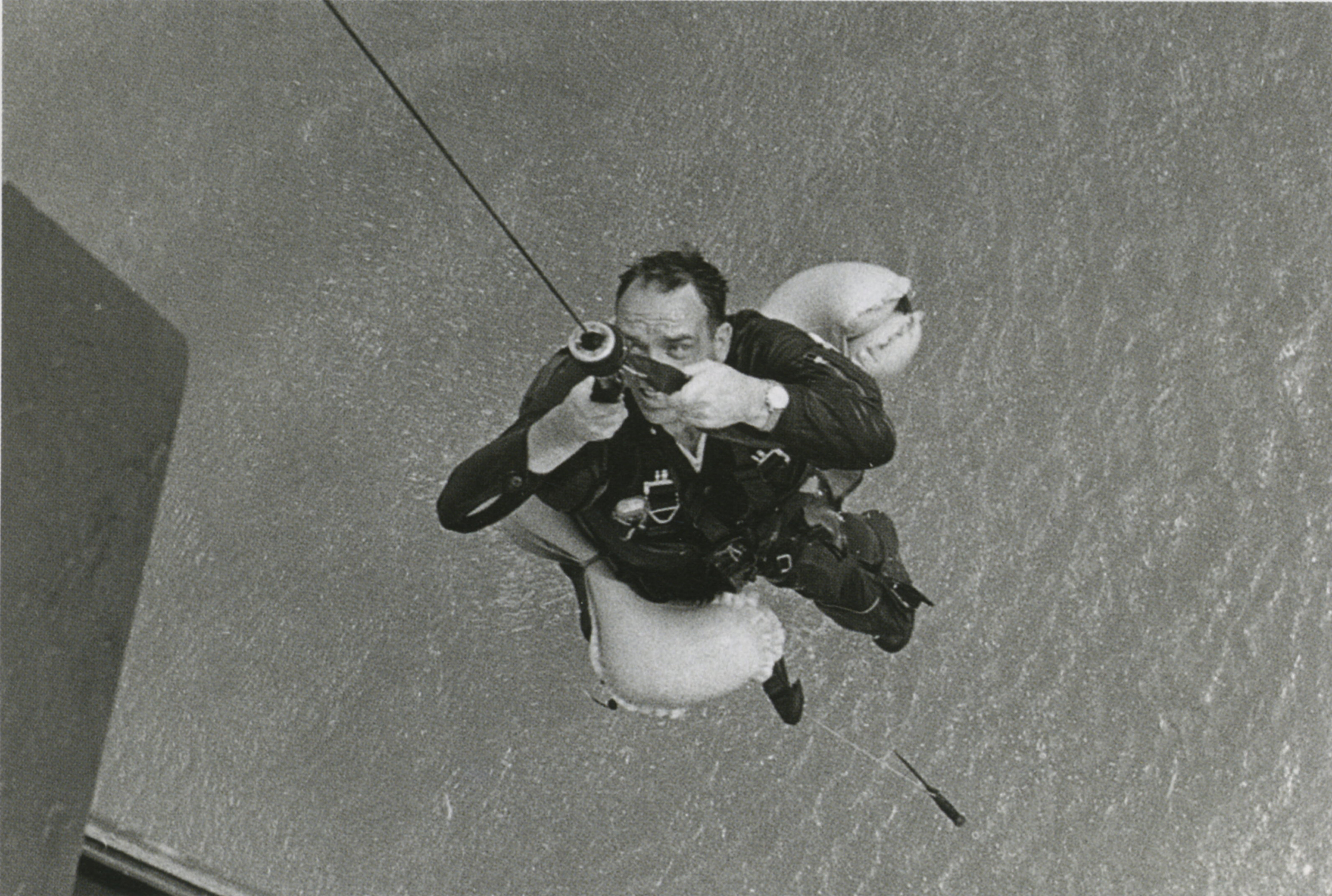
LCDR Tom Tucker is rescued from deep within Haiphong Harbor by Cdr Bob Vermilya, Ens Bill Runyon,
AWC Tom Grisham and ADR2 Jerry Dunford. PH2 Mike, a combat photographer assigned to the 7th Fleet was aboard the SAR helo
and took the following dramatic photos of the rescue. The photo of LCDR Tucker coming up the hoist has been used in numerous
publications and is one of the most well-known photos of the Viet Nam War.
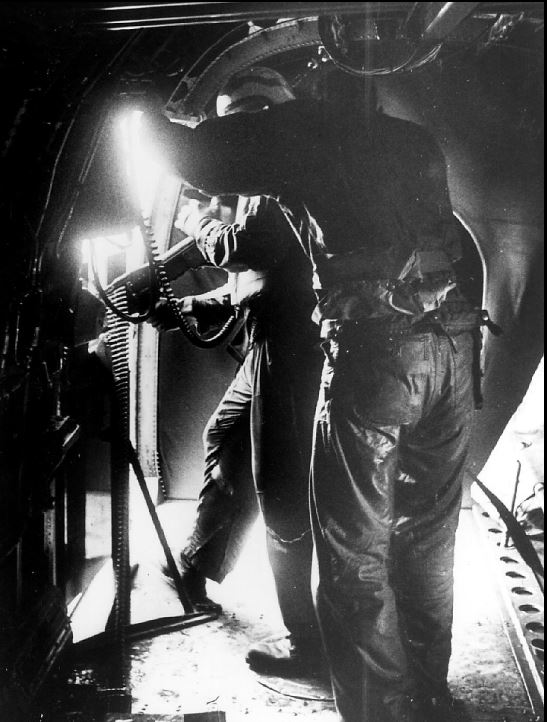
SH-3A door gunners at work against targets during the rescue
by pilot CDR Bob Vermilya of LCDR Tommy Tucker, VFP-63,
31 Aug ’66. Crewmen are AWC Tom Grisham (firing M60) and
ADR2 Jerry Dunford of HS-6.

U. S. Navy and U. S. Marine Corps Aircraft
Damaged or Destroyed During the Vietnam War by Douglas E. Campbell
Navy aircraft # 146874 was attached to VFP-63, Det G onboard
USS Oriskany (CVA-34). On 8/31/1966 the aircraft was near Quang Yen, about 5 miles NE of Haiphong, when it was hit by
ground fire. The pilot lost control of the aircraft and ejected at 1,500 feet into a Haihong shipping channel.
In a daring rescue, helicopter from USS Kearsarge flew up the channel at 50 feet, under intense gunfire, and rescued LCDR
Thomas A. Tucker, USM.


Commander Vermilya and his normal enlisted crewmen, AXC
Tom Grisham, and ADJ2 Jerry Dunford, and with his regular copilot, Ensign Bill Runyon, were flying the CSAR duty at North
SAR on August 31st 1966, and had just completed their second refueling of the flight, about eight hours into their day, when
they heard the voice of a very concerned Crusader pilot reporting the downing of his photo recce charge that had just been
shot down over Haiphong. The RF-8G, flown by Lieutenant Commander Tom Tucker, had tried to stack the deck as much in his favor
as he could for his recce pass over Haiphong harbor, given that his mission was to fly directly over one of the most heavily
defended places in North Vietnam in broad daylight, at photo-taking altitude, way too low for comfort, by himself, with no
one else to divide the concentration of the gunners, and takes pictures of the shipping in the harbor. He set up for a high
speed run from shore to sea over the port so that, if damaged, he would already be headed out to sea and relative safety.
Unfortunately for his prudent plan, the guns got to him a little too early for that plan to work as originally intended. He
got feet wet, but in the secondary shipping channel of Haiphong between the mainland and Dao Dinh Vu, not the open Ocean beyond
the range of the batteries lining the coast.
Tucker had run into the gantlet from
the beginning. Cannon to the right of him, cannon to the left of him, volleyed and thundered. Into the harbor of Haiphong
rode the 600-knot Lieutenant Commander. His not to reason why... Seeing the black puffs of the heavy 85mm AA guns, mixed with
the gray puffs of the medium 37mm AA guns, and the necklaces of green basketballs from a bunch of 12.7mm AA machine guns for
good measure, he could only jink and weave and hope for the best. The 37mm got him good and he lost control of his aircraft,
ejecting at 1500 feet. Floating down under a good canopy, Tucker was fired upon by AAA guns and small arms. He splashed down
not far from a Russian ship tied up at the quay wall. The Russian crew got busy with a lifeboat. Sampans and sailboats put
out from the shore, and men along the banks kept him under small arms fire. The lone Crusader up above, flown by Lieutenant
Commander Foster "Tooter" Teague, saw the boats coming out
and roared down in a strafing which sent then scuttling hack to shore where they beached themselves.
Teague was switching channels spreading the word and coordinating getting help. Every time he changed off Tucker's survival
radio frequency, Tom has a moment of panic until he checked back in. Vermilya knew that Harbor Master, the shipboard SAR commander
in the Gulf of Tonkin, needed to grant him permission to attempt the rescue has been easing toward the harbor, betting on
the come, expecting to get that permission shortly. He notified Teague that he was waiting for that permission and for RESCAP.
Tooter Teague replied plainly that if they don't come immediately, they need not bother coming at all. Vermilya, with Ensign
William Runyon, his copilot, and Chief Tom Grisham, with ADJ2 Jerry Dunford, his junior crewman, pushed the nose over and
began to speed toward the harbor at 3000 feet, theoretically above the effective AA gun altitude, and below the minimum SA-2
altitude.
As they entered the outer mouth of
the harbor, six miles from the entrance of the secondary shipping channel, two SAMs exploded right above them, and Vermilya
dove for the deck. So much for the briefed minimum SAM altitude; that was too close. They dropped to the deck, streaking across
the water at two or three feet as fast as the big helicopter could go. Teague swung around behind them and began making passes
first at junks along Big Mother's path, and then at the AA guns along the banks of the harbor.
Back in the channel, Tucker
noticed that the guns have stopped firing near him; there was no Crusader above him any more, so he scrambled into his one-man
raft, and started paddling away from the ships and shore. He
noticed a division of A-1 Skyraiders pass overhead, followed a short while
later by a division of A-4s, but the nearby guns were still holding their fire
for some reason. Then Tucker heard an approaching storm of gunnery, closing in.
Amid shell splashes, tracer fire, and harbor smoke, Big Mother threaded her way through the shipping in the harbor,
weaving right and left while keeping so low that Vermilya thought some of the guns checked fire for fear of hitting the shipping
on both sides of the helicopter. After all, most of the larger shipping was not North Vietnamese, but was neutral.
As
Big Mother neared the entrance to the shipping channel after crossing six miles
of outer harbor under fire, the two divisions of attack aircraft begin to strafe
the guns along the banks of the shipping channel, and the SA-2 missile
batteries in the area commenced firing. They were after the attack planes
overhead, which dodged them, but keep their attacks focused on the guns that
would be waiting for Big Mother.
Concentrating on dodging the splashes and the ships, and the junks, Big Mother passed right by Tucker, whose
red smoke flare was somehow missed in all the agitation. Chief Grisham, on the starboard gun in the cargo door, saw him behind
them after they had passed and called out the sighting. He also noticed sampans closing in on Tucker. Grisham and Dunford
engaged them with their M-60 machine guns, avoiding shooting their own rotors as Vermilya reefed the Big Mother around in
a tight high angle of bank turn, rolling right into an extreme nose-up flare to a quick stop rocking over into a hover right
above the raft. Tucker got into the sling correctly on the first try and in record time, and Vermilya nosed over, hardly having
been steady in a hover more than a few seconds, and not waiting for Tucker to be hoisted into the cabin. The helicopter turned
and began the gantlet back down the shipping channel and across the open harbor toward the open sea, reeling in Tom Tucker
as they went. As soon as Tucker was in the cabin, he admonished the crewmen for not firing their guns. He immediately moved
to the cabin gun, and fed the belt while Grisham began to put out defensive fire. Tucker was furious that he had been shot
at while in his chute, and yelled to Grisham that he wanted to stay and fight.
Big Mother cleared the harbor and the RESCAP broke off, and then the shooting
stopped. A check of the aircraft revealed that they had not taken a single hit. No one can believe it, not least the wet fighter
pilot who had been unable to avoid hits at four times the speed of the lumbering, to him, helicopter. From the first round
directed at them inbound, to the last round thrown at them in parting, Vermilya, Runyon, Grisham, and Dunford had been under
continuous fire for 20 minutes. Tucker was hoisted down to USS Towers, as the ship had closed the fight to just outside coastal
gun range in support, and now received Tom Tucker from Big Mother, which returned to an orbit around Towers, awaiting another
rescue call, her duty on station period for the day not yet over.
. This had been one of the most daring and dangerous rescue missions of the war,
and it had been caught on film. Photographers Mate Second Class Mike Delamore, had hopped the flight in hopes of getting some
footage of the daily business on Yankee Station. He got more than he bargained for and was as busy shooting film as Tom Grisham
and Jerry Dunford were shooting 7.62 ammunition.

This photo of the USS Kearsarge was taken 5 July 1666 in Hawaiian waters, with S-2 and E-1B planes and
SH-3 helicopters on her flight deck. This was the home of CDR Vermilya during the time of the rescue of LCDR Thomas
Tucker on 31 Aug 1966.
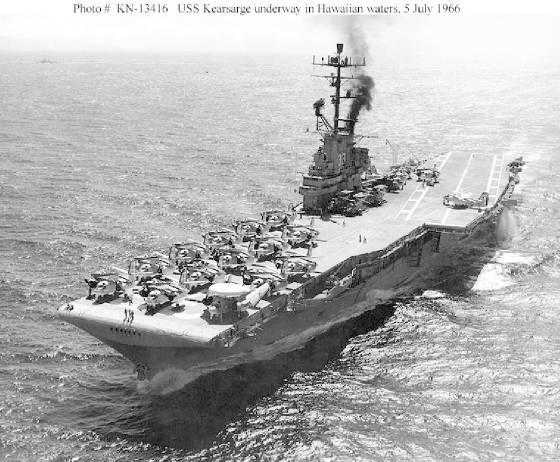

From the book "Dictionary of American Naval
Fighting Ships, Volume 3, published by the Government Printing Office.
The guided missile
destroyer USS Towers (DDG-9) returned to Subic Bay for upkeep and further training in PT-boat
counter-measures before she returned to the Gulf of Tonkin to take up her
position on the northern SAR station on 1 August. For the next month, she deployed
with Wiltsie (DD-716), keeping on the alert to spot downed pilots and to direct
friendly helicopters to the rescue.
On 6 August, Towers
directed an HU-16 helicopter to the site of a downed aviator some 69 miles from
the ship. The next day, Towers directed another HU-16 to a spot behind the
enemy-held island of Cac Ba, where two Air Force men had bailed out. The
"chopper" successfully rescued them from behind communist lines. In
the next two weeks, the ship participated in two more rescues—picking up two
more Air Force pilots in one and a Navy flyer in the other.
Towers' most daring
rescue came on the last day of her tour on the SAR station. On 31 August, a
Navy plane was hit by antiaircraft fire over Haiphong, and the pilot bailed out
of his doomed aircraft directly over the enemy harbor. As he floated down under
his parachute to face what seemed certain couture, Towers and the USS King (DLG-10)
closed to within visual range of Haiphong harbor. Then King's helicopter sped
in under the guidance of Towers' experienced controllers and picked up the
pilot, whisking him out of danger from beneath the enemy's very nose.
(My
note: This official history is in error
above as the helicopter came from the carrier USS Kearsarge (LHD-3) and was
assigned to helicopter squadron HS-6.)

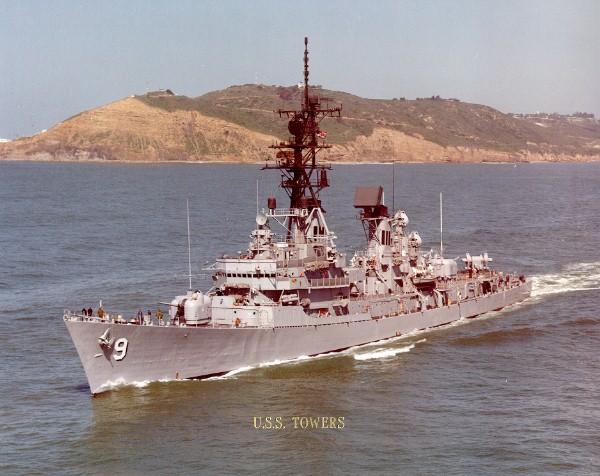

El Paso Herald Post, 3 September 1966

Pasadena CA Independent Star, 3 September 1966

Kokomo Indiana Morning Times, 4 September
1966
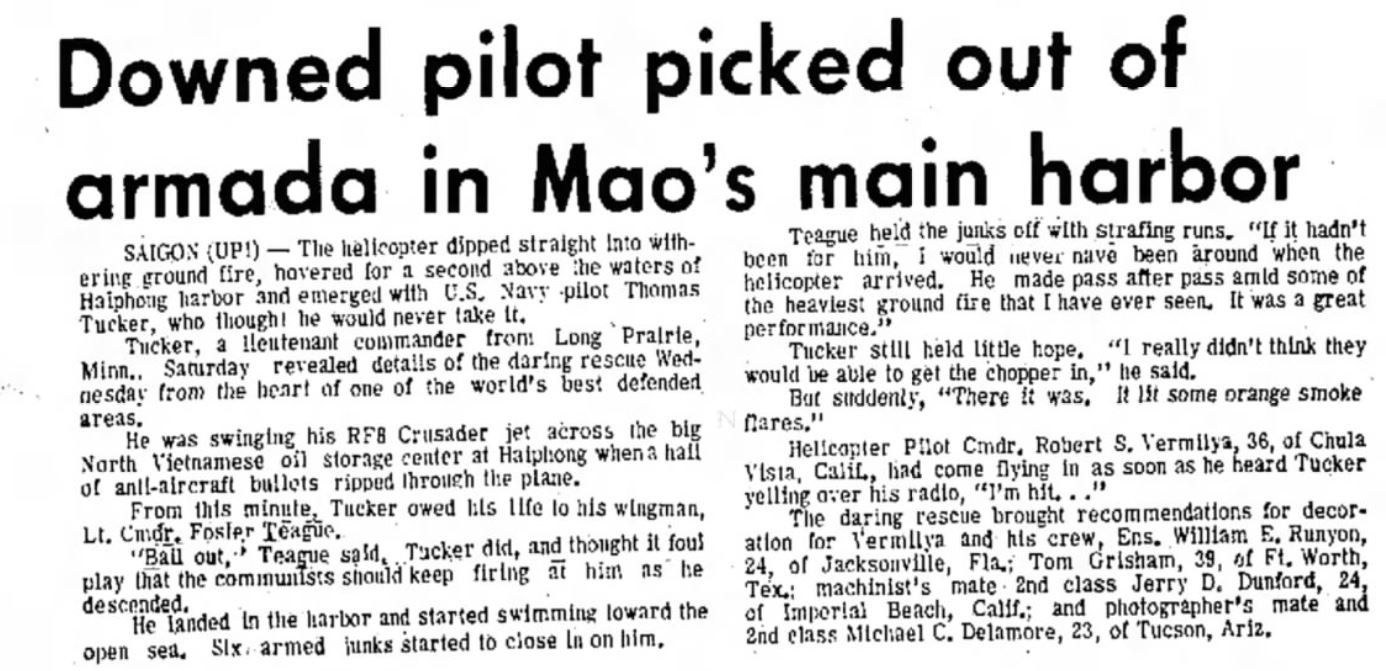
Charleston Sunday Gazette, 4 September 1966
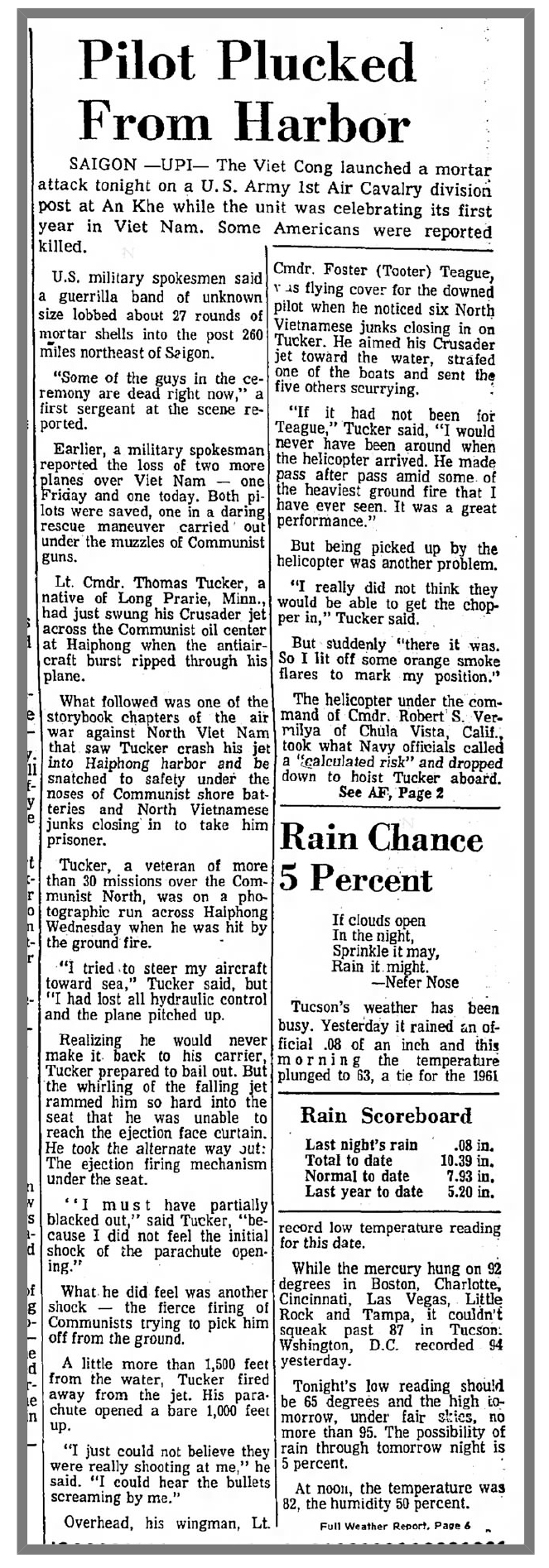
El Paso Herald Post, 3 September 1966
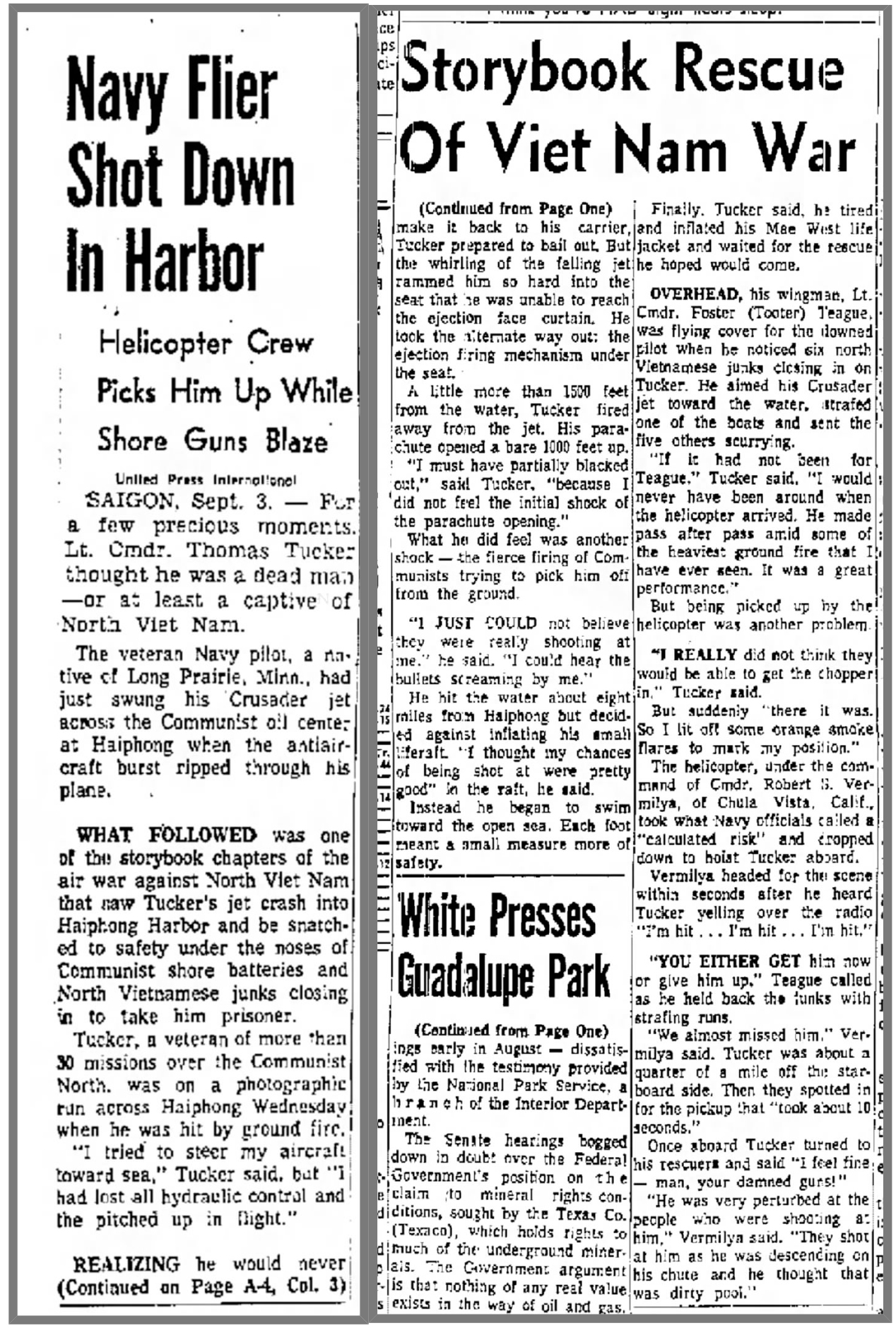
|

